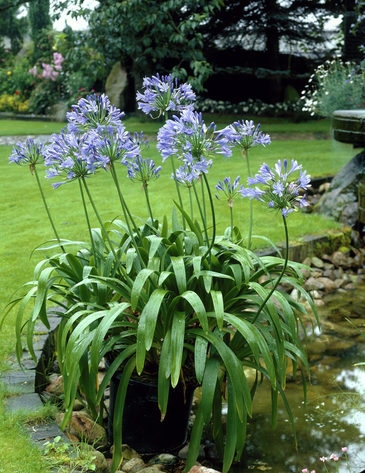
Also called lily of the Nile, agapanthus is not a lily at all. Nor is it from the Nile. It is actually from the southern part of Africa, not the northeastern part where the Nile River flows.
Still, agapanthus does have some qualities in common with lilies. If you have clumps of either agapanthus or daylilies that are getting too crowded for their space, it is time to divide them.
Were your agapanthus blooms as robust and plentiful this year as in years past? If blossoms have dwindled to just a few flowers, do a little detective work. Both agapanthus and daylilies can become root-bound, even planted in the ground.
Take a close look at the roots at soil level. If the crown of the plant is beginning to show above the soil or roots are apparent above ground, it is probably time to split the clump. Thick roots can begin to intertwine and choke themselves if you don't intervene. Typically, agapanthus and daylily clumps need to be divided every four to six years.
It is hard work to dig up a well-established clump of tuberous roots, but it gives you the opportunity to spread more flowers around your garden. Alternatively, you can give starts of blue or white agapanthus to gardeners lacking these upright, stately plants.
If the root clumps are really big or overgrown, enlist help. Some gardeners prefer to use garden forks to separate the tangled roots into three or four sections. Other gardeners cut straight through roots with a sharp, straight shovel, like slicing a pie into quarters.
Agapanthus roots are tough. Brush or rinse off the dirt and remove any dead, soft or weak-looking roots. Make sure each division has at least one or two growing points. Weed and prepare their new or revived bed and replant.
Agapanthus likes good drainage, but it does not need a super-cushy bed. Too much nitrogen can produce tender foliage that is more easily damaged by frost. Space new plants 12 to 18 inches apart.That's enough room to grow, yet close enough to help each other stay upright. Tall varieties that can reach 4 to 5 feet in height need more space than short varieties like ‘Peter Pan,' the agapanthus that “never grows up.” These dwarf varieties top out at about 18 inches and are useful in the front of mixed beds or along borders.
Agapanthus is a star in garden beds, attracting honey bees, ground bees and a variety of other pollinators. Agapanthus does well in large containers, too, so pots on the deck or patio can be a good solution if you have garden areas that are too waterlogged in winter to host them. Most agapanthus come in hues of blue and blueish-purple, but white agapanthus are common, and pink blossoms are available, albeit more rare.
In my experience, agapanthus is very forgiving. An agapanthus in a five-gallon pot sat on my deck for four years, finally getting so obviously crowded that I had to free it. That one pot provided a 15-foot-long border of liberated agapanthus. All were blooming within a few months, rewarding my deferred maintenance.
Whether in roadside plantings or in cottage gardens, agapanthus is an easy-care favorite. Preferring sunny, well-drained soil with south- or west-facing exposure, the plants flower from midsummer to early autumn.
After flowering, cut the stalks but leave the strappy foliage to collect energy from the sun and prepare for next year's bloom. If uncut, the flowers will develop blackish-brown seeds that open and drop on the ground.
You can grow agapanthus from seed, but you have to be patient. It may take two or three years before blossoms appear. Still, agapanthus seeds germinate reliably, so if you enjoy growing plants from seed and have room in your garden for baby agapanthus, starting from seed is an economical way to grow them. Instructions for collecting and propagating seeds can be found on The Royal Horticultural Society's website, along with information on different cultivars to consider for your garden.
Workshop: U. C. Master Gardeners of Napa County will conduct a workshop on “Succulent Gifts” on Sunday, November 8, from 2 p.m. to 4 p.m., at the Yountville Community Center, 6516 Washington Street, Yountville. Bring your own love of succulents to this workshop dedicated to making gifts for the holidays or for yourself. Master Gardeners will concentrate on the right kind of soil and care for succulents, discuss the myriad succulent types, and help you make a succulent garden or two to give as gifts. Please bring succulent cuttings if you would like to share. Call 707-944-8712 to register or visit the Parks and Recreationweb site.
Master Gardeners are volunteers who help the University of California reach the gardening public with home gardening information. U. C. Master Gardeners of Napa County ( http://ucanr.org/ucmgnapa/) are available to answer gardening questions in person or by phone, Monday, Wednesday and Friday, 9 a.m. to Noon, at the U. C. Cooperative Extension office, 1710 Soscol Avenue, Suite 4, Napa, 707-253-4143, or from outside City of Napa toll-free at 877-279-3065. Or e-mail your garden questions by following the guidelines on our web site. Click on Napa, then on Have Garden Questions? Find us on Facebook under UC Master Gardeners of Napa County.